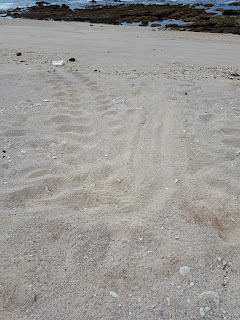Since the beginning of the turtle nesting season, no turtles
had been encountered yet...but turns out Will our newest volunteer had the
lucky charm, on his first patrol...the first encounter was also recorded!
Below is his description of his experiences so far.....
 |
| First day on patrol |
My name is Will, I am 22 and from England. Having just
graduated from university with a BSc in geography I was ready to go out and use
my acquired skills to help the world, which was when I applied to be a
volunteer at MCSS. I have been in the beautiful nation of the Seychelles for
just over a week now, working with MCSS at their Banyan Tree Resort
conservation centre in the south of Mahe.
Among other things, I am largely involved in the sea turtle
monitoring programme. This consists of morning patrols along some of the main
nesting beaches here in the south of Mahe, where the critically endangered
hawksbill turtle comes to lay eggs. The Seychelles is one of only two places in
the world where the hawksbill nests during the day, whilst other species nest
at night - including the green turtle, which also nests locally.
 |
First turtle for the season
|
During a patrol we are looking for distinctive tracks in the
sand where a turtle has hauled itself up the beach and beyond the high tide
line to dig a body pit, lay eggs and then re-cover and camouflage the site
before returning to the sea. Track widths are measured as an indication of the
turtle’s size and the nest is GPS recorded for future monitoring.
If we are lucky (as I was on only my first day!), we may
find a turtle mid-way through nesting. During this time it is very important to
abide by the ‘turtle watchers code of practice’ so as not to disrupt such a
delicate and vital process. Namely this involves: approaching from
behind, moving slowly and staying quiet, maintaining a respectful distance and
not surrounding or trapping the turtle in anyway, giving it a clear path to the
sea at all times. Once the turtle has begun laying, we approach to collect
data on the size of the carapace (shell top) and check the animal for any tags
or damage. Photos are taken of both sides of the head, where a unique layout of
scales acts as the ‘fingerprint’ of the turtle, allowing us to individually
identify it in a computer database.
We have also recently begun using drones to patrol some of
the more inaccessible beaches, particularly on the lookout for poachers.
Unfortunately, poaching of sea turtles is still a major global issue, despite
their internationally protected status and even here in the island paradises of
the Seychelles. To think how someone could murder such a beautiful, innocent
and defenceless creature is completely beyond me.
 |
second encounter on Anse Bazarca
|
Sea turtle monitoring programmes here and around the world
are of great importance if we are to conserve these critically endangered
animals, whose populations continue to decline, mostly due to our own
shortcomings - poaching, pollution, over-development and habitat destruction.
The threat of global climate change will also continue to hamper turtle
populations as sea levels rise, drowning previously viable nesting sites and
raising beach temperatures, which are believed to be causing an imbalance in
gender ratios (turtle hatchling sex is determined by temperature in the nest,
with temperatures above ~29C resulting in females and below in males). Moreover,
there is likely to be more adverse effects not yet accounted for or understood
- e.g. This season has been especially slow to start, with only half the number
of turtle nests recorded compared to the same time in the previous few years.
 |
off she goes!
|
I feel extremely fortunate to take part in this important
work and to witness a nesting turtle on my first day and again on my fifth. To
sit next to and closely watch such an incredibly beautiful, graceful and
endangered animal is a true privilege, providing memories I shall cherish
forever.
I can only hope that our work and that of the global
conservation community is enough to ensure the survival of this prehistoric
creature long into the future. These environments and the species that occupy
them are so stunning, but also so fragile, we cannot afford to take them for
granted or we will lose vital keystones in the ecosystem and indeed essential
elements that make living on Earth such a pleasure.
 |
she drew in a crowd for sure!
|













































